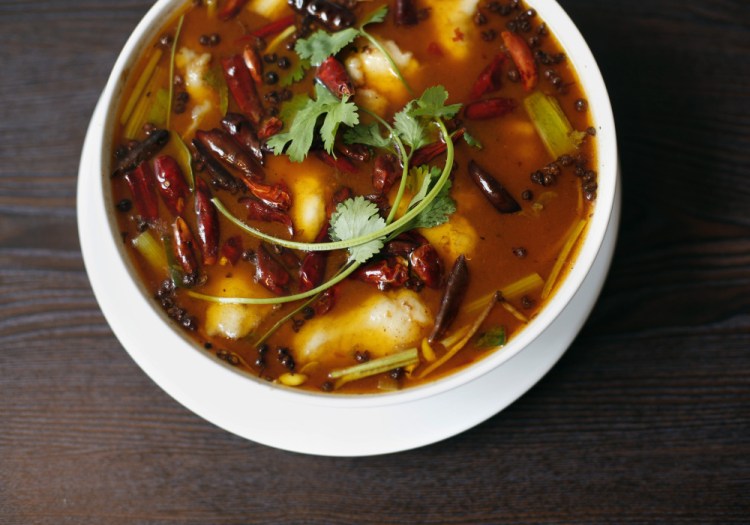If you are a design snob, you may have walked past Sichuan Kitchen on Congress Street without giving it a second thought. Maybe their penchant for Comic Sans made you turn up your nose. Perhaps it’s the restaurant’s spartan interior design, making the dining room feel like a minimalist stage set for a slow-moving Norwegian sitcom about people living in a duplex apartment.
Possibly it’s not aesthetics but fear of spice that has kept you away. If you, like many people, believe that Sichuan (formerly written as “Szechuan”) cuisine is all about atomic levels of peppery heat, you might have allowed your misconceptions to convince you not to visit owner Qi Shen’s new restaurant.
Either way, you’re missing out on something special.
Shen and her kitchen team – both of her parents (who together once operated a large banquet restaurant in Chengdu), an aunt and a local line cook – have assembled a menu of traditional regional dishes from across China’s rainy, hot and mountainous Sichuan province. They take the restaurant’s theme seriously, as well. You will not find egg rolls or American inventions like crab rangoons here. And while you can find gung pao (kung pao) chicken ($15) and mapo tofu ($13) on the menu, that is because both dishes hail from the region.
“There is so much to authentic Sichuan food,” Shen explains. “There are hundreds of dishes and hundreds of styles and flavors: fresh, sweet and yes, even some spicy, but not all! Every single dish has its own shape and flavor.”
Some take on forms that echo the familiar, like Zhong dumplings ($7), crescent-shaped parcels filled with lean ground pork loin and ginger. Served in a small bowl and double-drizzled with sweet, smoky chili oil and a housemade infusion of soy sauce, garlic, sugar and aromatic spices like star anise, the dumplings must be sloshed around to mix the duo of sauces before they are eaten. The slick little dough packages resist being grabbed by chopsticks once they’re coated, but the effort is well worth it.
You’ll also spot something recognizable in the Sichuan noodles with pork ($12), which apart from the slice of steamed bok choi added as garnish, might as well be a bowl of spaghetti bolognese with a fake ID. But look closer and you’ll see that the noodles are square-cut egg-and-wheat pasta, tacky with a sesame paste dressing that grabs hold of toppings like green onion and the quick-fried pork crumble, arcing with lightning bolts of ginger and garlic.
Yet to get to the restaurant’s best dishes, you have to be willing to give up preconceptions about what Chinese food is (and, more importantly, is not). There’s an appetizer of smoky firm tofu, slow-braised with cloves, Sichuan peppercorns, cinnamon and fried peanuts ($8) – a plateful of seductive fragrance and wacky Cubist geometrics.
Or a generous if slightly too-fatty entrée-sized portion of thinly sliced pork belly ($16), marinated in funky doubanjiang, a sauce made from red peppers and fermented beans. Despite the presence of chili, the dish is primarily savory and a little sweet. “Doubanjiang gives it just an entry level of spice. You can’t taste much heat because it has a very rounded flavor from the fermented soybeans. It’s not what people expect,” Shen explained.
Equally surprising was what arrived at the table when I ordered the modest-sounding Sichuan poached fish ($22): a tureen of broth-simmered Swai fillets, skinny stalks of Chinese celery and organic leeks, all sprinkled with dried chilies and a constellation of crispy, mouth-numbing Sichuan peppercorns. While the dish was very salty (probably too salty) on its own, when ladled over a scoop of steamed rice, its parade of flavor contrasts found a much better balance and rhythm.
At the opposite end of the flashiness spectrum is a bare-bones platter of wok-sautéed cabbage ($8). Served with no garnish whatsoever, its austerity makes it look like something taken from a Russian babushka’s wartime recipe book. But a slice or two, coated with a caramel-brown sauce of soy, sugar and tart black vinegar made me set down my chopsticks and urge my dinner guest to get stuck in before I ate the entire plateful. I never envisioned that something could actually make me crave cabbage, and I certainly never imagined it would be a dish that looks as humble as this.

Restaurant workers prepare for evening service at Sichuan Kitchen.
Nor would I have pictured a torrid cabbage love affair beginning in such a largely unadorned dining room. According to Shen, that’s a temporary situation: “It took us a year and a half to renovate, and this is a historical building, so the standards are different. We just didn’t have the finances to do a lot (of decorating),” she said. At the same time, her vision for the space is driven by her awareness that Sichuan Kitchen is not a typical Chinese-American joint. “I didn’t just want to put a red lantern or a dragon up to express, ‘Hey, I’m a Chinese restaurant,’ ” she said.
Proceeding deliberately with design choices seems like a wise choice for a restaurant as unique as hers. What Qi Shen is doing – has already done – at Sichuan Kitchen is impressive, and if the space never gets its fairytale, cygnet-to-swan makeover, that’s OK. It won’t take long before rumors of slippery dumplings and simple yet irresistible cabbage lead diners to her quietly understated doorstep.
Andrew Ross has written about food in the United Kingdom and in New York, where he co-founded NYCnosh, a food website. He and his work have been featured on Martha Stewart Living Radio and in The New York Times. He is an Internet researcher and higher education consultant. Contact him at:
andrewross.maine@gmail.com
Twitter: @AndrewRossME
Send questions/comments to the editors.


